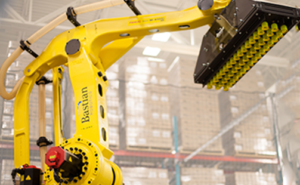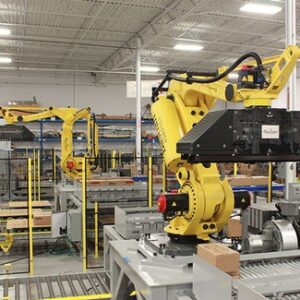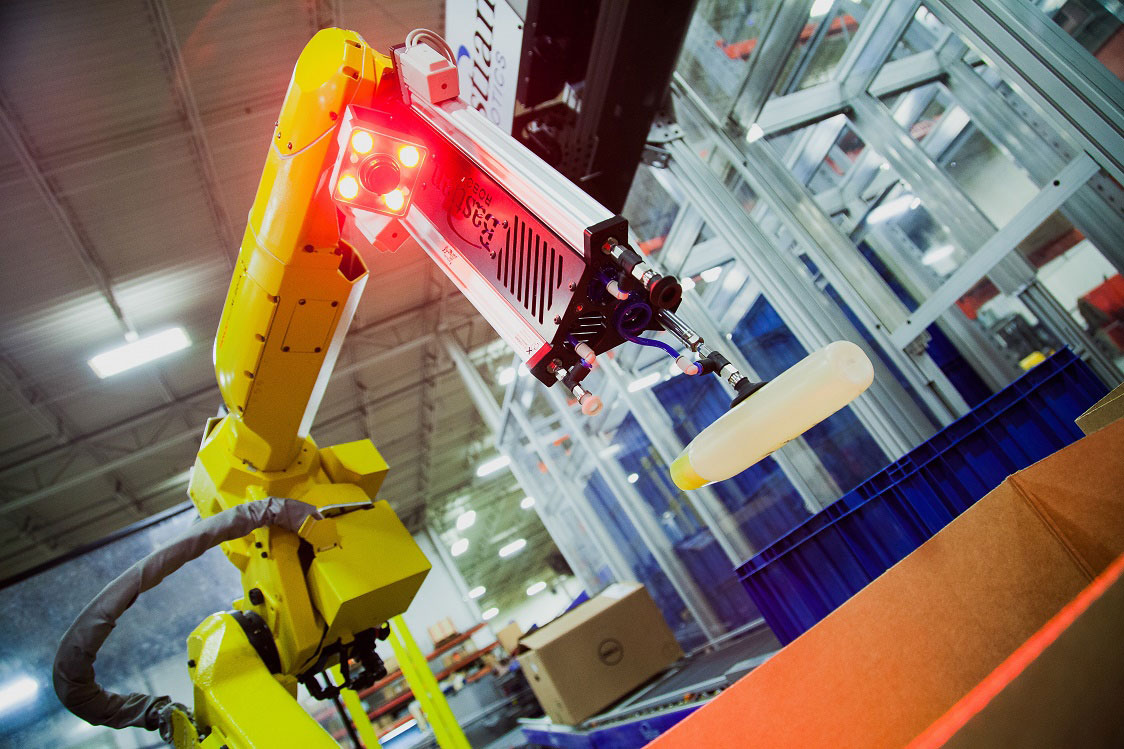In this blog post, Toyota Material Handling Solutions’ Director of Sales and Marketing Anthony Spano answers frequently asked questions about robotic palletizing systems and solutions.
Anthony has a decade of expertise in maximizing cube utilization and increasing throughput by employing the ideal mix of automation, software, and labor. His superpower is using high-performance solutions to help companies optimize productivity and deliver fast, accurate fulfillment to match the speed of modern commerce.
What is a robotic case palletizer?
A robotic palletizer employs a robotic arm to pick, orient, and place individual products and arrange them into a single stack or load.
What are the benefits of a robotic palletizing solution?
There are numerous benefits of using a palletizing robot, but I will stick to the top five.
- Increased productivity: Palletizers eliminate manual labor for unitizing products. They are much more efficient, lift heavier loads, and perform faster.
- Better product handling: Since palletizers are automated machines, their movements are pre-programmed to function without damaging the product.
- Small and flexible: Palletizing robots typically have a smaller footprint than other solutions, offer greater flexibility, and fit in extremely tight spaces.
- Improved workplace safety: Robotic palletizers eliminate many workplace hazards typically associated with manual labor like falling, tripping, and muscle strains from repetitive actions.
- Reduced operating costs: Most operations can save money by increased productivity, low product damage, and reduced labor costs.
How does a robotic case palletizer work?
A palletizing robot picks one or multiple cases from a conveyor system and places them on a pallet. The process continues layer by layer until the pallet is complete.
How does the palletizing robot know what to pick and place?
Pallet patterns, which can easily be changed or added, are programmed into the palletizing robot.
What is the function of an end-of-arm tool? 
The end of arm tool can handle multiple types of containers simultaneously, regardless of their shape. It can pick up cases, bags, pails, bottles, batteries, cubes of scrap metal, plastic containers, and many other things.
Can a robotic palletizing solution handle different patterns and product types?
Yes. A robotic palletizer can handle one or more units according to pallet configuration and forms multiple layers on a pallet after picking the products off a conveyor.
Can a palletizing robot handle multiple feeds of different SKUs on the same line?
Yes. There are systems to send information to the robot to pick and place different SKUs on different pallets.
How much weight can a palletizing robot handle?
Robotic palletizing systems can typically handle up to 2,200 pounds.
How fast are palletizing robots?
For a single robot picking a single product, palletizing rates can vary anywhere from eight to thirty cases a minute, depending on stacking patterns and other requirements.
How long can a palletizing robot operate?
Unlike human labor, palletizing robots do not experience exhaustion or injuries. With proper maintenance, palletizers can reliably operate 24/7.
Can a robotic palletizing system and solution serve multiple lines?
Yes. One robotic palletizer can work between two or more packaging lines.
Can a palletizing robot perform secondary tasks?
Yes, some robotic palletizers have a vacuum, magnetic, or custom end-of-arm tools to give them the ability to perform additional tasks such as slip sheet dispensing, pallet placing, and wrapping.
 Can a robotic palletizing system reverse its operation?
Can a robotic palletizing system reverse its operation?
Yes. This feature is on robotic palletizers-depalletizers.
What industries typically use robotic case palletizers?
You can find palletizing robots in many industries, including food and beverage, life sciences, packaged goods, electronics, and more.
Are there pictures and videos available?
Yes, click here for pictures and videos of robotic palletizers in action.
Do you have other automated warehouse solutions?
Yes. Click here for tips on how to upgrade your warehouse for maximum efficiency.
Implementing a robotic palletizing system requires knowledge and planning. Let our team of storage and automation experts design a unique plan just for you.
If you are in Los Angeles County, contact us for a free consultation today.
Tags: automation, free resources, warehouse solutions
